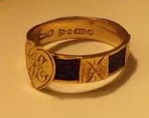Elizabeth Hopkinson is a fiction writer from Bradford, West Yorkshire, UK. She has had over 40 short stories and articles in magazines, webzines and anthologies, a historical fantasy novel – Silver Hands – from Top Hat Books, and has won prizes in the James White Award, the Jane Austen Short Story Award and the Mifiction Interactive Fiction Contest.
 My great-grandmother’s ring came to me in a rather random way. I was told, “It has a letter E on it and you’re the only one in the family whose name begins with E.” I was also told it was a “hair ring”, but I didn’t know whose hair was in it, and nor did anyone else, seemingly. I wasn’t sure how I felt about a ring containing human hair. Besides, the initials on the ring turned out to be JE, and there is no J in my name. The ring stayed tucked away in a drawer, with no associated emotions other than guilt that I didn’t feel more connection with it.
My great-grandmother’s ring came to me in a rather random way. I was told, “It has a letter E on it and you’re the only one in the family whose name begins with E.” I was also told it was a “hair ring”, but I didn’t know whose hair was in it, and nor did anyone else, seemingly. I wasn’t sure how I felt about a ring containing human hair. Besides, the initials on the ring turned out to be JE, and there is no J in my name. The ring stayed tucked away in a drawer, with no associated emotions other than guilt that I didn’t feel more connection with it.
Things only changed when I decided to take the ring to the BBC Antiques Roadshow in 2010. By now, I knew more about my family history. I also had an idea that the ring was probably a mourning ring. But who was my great-grandmother mourning? Whose was the hair in the ring?
My great-grandmother – who I remember as a small, frail woman called Little Grandma – was born Jane (Jeannie) Smilie on 5th October 1890 in Sunderland, Tyne & Wear. She married my great-grandfather, David Cumming (a distant cousin), in JuIy 1914 in Lochore, Fife. Together, they had six children. Two of those died in childhood: Ethel, who died in infancy, and Florence (Florrie), who died of TB, aged 11. Was Jeannie mourning a lost child? Did the E stand for Ethel, possibly Jane Ethel, a first child named for her mother?
The dates I had for Ethel’s birth and death were vague and a little contradictory, but I took what I had to the Roadshow. My research was almost instantly shattered when the first valuer to take the ring said, “Victorian mourning ring”. Victorian? Had I got this all wrong, then? But when she failed to find the hallmark in her books and passed the ring to John Benjamin, he said, no, this was a later piece. I was right first time. But it looked Victorian. Interesting.
Even more interesting was the hallmark. The ring was 9 carat gold, hallmarked Chester, 1915. 1915 . So it was Ethel’s initials and hair. A conversation with my cousin confirmed that Ethel was born and died in 1915. But Chester? My great-grandparents lived in Fife. A little logical thought and further reading on mourning rings revealed a deeper seam to my great-grandparents’ story.
There are lots of hairwork mourning rings online. The vast majority are Victorian. They are also better made and more expensive than Jeannie’s ring. It is hard to find one dated as late as 1915. The fashion was dying out. Jeannie’s was a cheap copy of a type of ring already passé in fashionable circles. And it was mass-produced. The bare ring was made in Chester with hundreds of others, the hair and engraving added in Fife. An almost identical ring can be seen on Pinterest, dated 1901-2. Jeannie and her relatives could even have worked the hair themselves in their own home using printed instructions. This was the mourning of a working class mother, far from the centres of fashion, doing the best she could afford for her lost baby. The Cummings were no strangers to hardship. In 1918, David’s hairdresser’s shop, which he had started himself, aged 18, burned down. And in 1926, the General Strike forced the family to move to Sunderland and rely on the support of the Smilies. They never went back to Fife. Ethel’s death was one tragedy among many sorrows for my great-grandmother, including the death of another daughter.
There is no ring for Florrie. The First World War put an end to most of the sentimental Victorian mourning customs. The Cummings themselves suffered loss in the conflict, losing David’s brother Robert Henderson Cumming at Beaumont-Hamel in 1916. In the same year, David was sent to work as a timber man at the “Big Mary” at Crosshill Pit to help the war effort. And Jeannie gave birth to another baby – another David Cumming – my grandfather, who grew up effectively as the eldest child. He remembered Florrie, but not Ethel. But Jeannie never forgot. The ring was with her for the rest of her life. And then it came to me.
The small, frail woman called Little Grandma never told me this story. The ring told me, little by little. And in so doing, transformed itself from an old hair ring into an emotional object.

I love this post. Thank you for sharing the story of this ring.